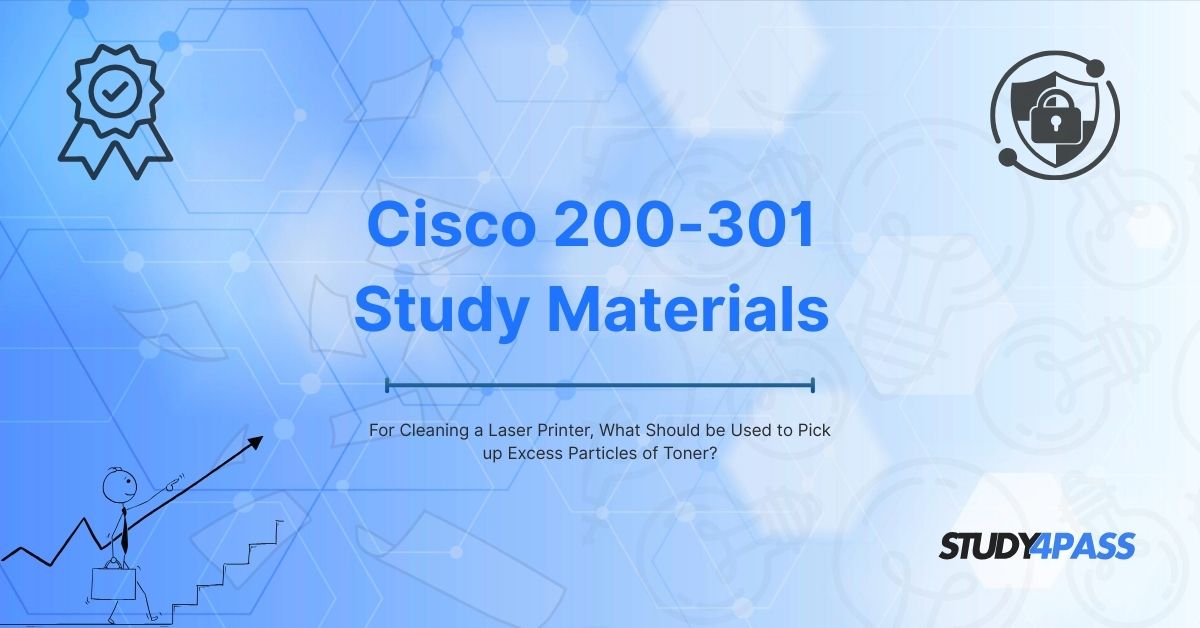Introduction to 200-301 CCNA Study Material
Laser printers are essential in both office and home environments, offering high-quality prints at impressive speeds. However, they require regular maintenance to function optimally. One critical aspect of maintenance is cleaning excess toner particles, which can accumulate inside the printer and cause print defects, streaks, or even hardware damage.
For IT professionals, particularly those preparing for the Cisco 200-301 exam, understanding printer maintenance is crucial. The 200-301 CCNA exam covers various aspects of IT operations, including basic device maintenance. Using the right tools to clean a laser printer ensures safety and efficiency, which aligns with the best practices emphasized in Study4Pass 200-301 exam prep practice test and study materials.
Recommended Tool: Toner Vacuum or Anti-Static Vacuum
The best tool for picking up excess toner particles is a toner vacuum or an anti-static vacuum. Here’s why:
- Specialized Design – Toner vacuums are designed with anti-static properties to prevent toner particles from sticking to internal components due to static electricity.
- HEPA Filtration – These vacuums use High-Efficiency Particulate Air (HEPA) filters to trap fine toner particles, preventing them from being released back into the air.
- Safety – Unlike regular vacuums, toner vacuums do not generate excessive heat, reducing the risk of combustion (toner is flammable when dispersed in the air).
Why a Regular Vacuum is Dangerous?
- Static Buildup – Standard vacuums generate static, which can cause toner to clump and damage printer components.
- Poor Filtration – Toner particles are extremely fine and can pass through regular vacuum filters, contaminating the air and posing a health risk if inhaled.
For IT professionals studying with 200-301 exam prep practice test, knowing the correct tools for device maintenance is essential for both real-world applications and certification exams.
Alternative (If a Toner Vacuum is Unavailable): Lint-Free Cloth or Microfiber
If a toner vacuum is not available, the next best option is a lint-free cloth or microfiber towel. Here’s how to use them safely:
- Turn Off and Unplug the Printer – Always ensure the printer is powered down to avoid electrical hazards.
- Gently Wipe Surfaces – Lightly dab the toner spills instead of rubbing to prevent spreading.
- Dispose of the Cloth Properly – Toner is hazardous, so seal the used cloth in a plastic bag before disposal.
Why Paper Towels or Compressed Air Are Not Ideal?
- Paper Towels – Can leave fibers behind, which may interfere with printer mechanics.
- Compressed Air – Blows toner particles into the air, increasing inhalation risks and spreading contamination.
For Cisco 200-301 exam candidates, understanding these alternatives reinforces best practices in device maintenance, a topic often covered in Study4Pass 200-301 study guides.
Tools and Methods to Avoid
Some cleaning methods can damage the printer or pose health risks. Avoid the following:
- Regular Household Vacuums – As mentioned, they generate static and lack proper filtration.
- Damp Cloths or Water-Based Cleaners – Moisture can cause toner to clump and damage electrical components.
- Brushes with Stiff Bristles – These can scratch sensitive printer parts like the drum unit.
- Bare Hands – Toner can irritate the skin and should never be touched directly.
Safety Precautions When Handling Toner
Toner is a fine powder that can be harmful if mishandled. Follow these safety measures:
- Wear Protective Gear – Use gloves and a mask to avoid skin contact and inhalation.
- Work in a Well-Ventilated Area – Prevents toner particles from accumulating in the air.
- Avoid Shaking Toner Cartridges – Reduces the risk of spills.
- Follow Manufacturer Guidelines – Always refer to the printer’s manual for specific cleaning instructions.
For CCNA 200-301 aspirants, safety protocols are part of broader IT operational standards, making this knowledge valuable for both exams and real-world scenarios.
Exam Context: Cisco 200-301 Certification
The Cisco 200-301 exam validates a candidate’s ability to manage and troubleshoot network devices, including peripherals like printers. Key topics include:
- Device Maintenance Best Practices – Proper cleaning techniques ensure longevity and performance.
- Safety Protocols – Handling hazardous materials (like toner) aligns with workplace safety standards.
- Troubleshooting Print Quality Issues – Understanding toner-related problems helps in diagnosing print defects.
Using Study4Pass 200-301 exam prep practice test ensures you grasp these concepts effectively, with real-world scenarios and exam-focused content.
Final Words
Cleaning a laser printer requires the right tools and precautions to ensure safety and efficiency. A toner vacuum is the best choice, while a lint-free cloth serves as a good alternative. Avoid unsafe methods like regular vacuums or compressed air, and always prioritize safety when handling toner.
For Cisco 200-301 certification candidates, mastering these details is crucial—both for the exam and professional IT environments. Study4Pass 200-301 exam prep practice test provide comprehensive coverage of such topics, helping you achieve CCNA Certification success with confidence.
By following these guidelines, you’ll keep your laser printer in top condition while adhering to best IT practices—essential for any aspiring network professional.
Special Discount: Offer Valid For Limited Time “Cisco 200-301 Exam Prep Practice Test”
Sample Questions for Cisco 200-301 Exam Prep Practice Tests
Actual exam question from Cisco's 200-301 Exam.
For cleaning a laser printer, what should be used to pick up excess particles of toner?
A) A damp cloth
B) A vacuum cleaner with a HEPA filter
C) Compressed air
D) A dry paper towel


